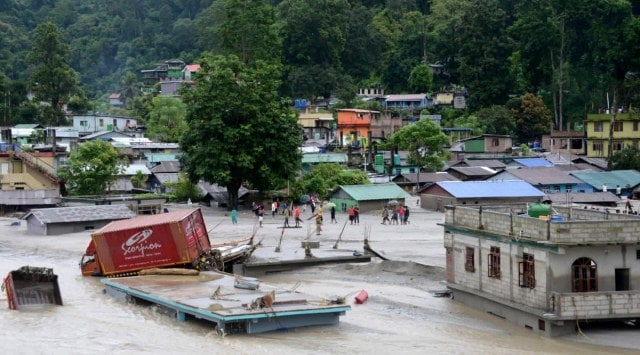In its first attempt at explaining the reasons leading up to last year’s flooding that ravaged four districts and killed over 40 people, the Sikkim government has informed the National Green Tribunal (NGT) that “more than usual heavy rainfall” — possibly a cloudburst — had preceded the glacial lake outburst flood (GLOF) event in the South Lhonak lake.
The state government has based its conclusion on a report by the North East Space Application Centre (NESAC), which supports the Northeastern region with space science and technology. NESAC analysed rainfall before and after the GLOF using satellite data.

Crucially, however, its report mentioned that satellite data for rainfall was not available for about three hours when the incident happened. But, it added, it had rained heavily before the GLOF and there had been chances of more rain.
The Sikkim government’s account — filed in its affidavit to the Kolkata bench of NGT, which had taken suo motu cognisance of the October 3 disaster — seems to confirm the initial suspicion of the National Disaster Management Authority that heavy rainfall could have triggered the series of events that resulted in the disaster.
Last year, 40 people were killed and 76 went missing during floods in at least four districts of Sikkim after the water levels of the Teesta River rose as the South Lhonak Lake — a glacial lake situated in the state’s northwest at 17,000 feet — burst, leading to the release of water in downstream areas. Around 100 villages in these four districts — Mangan, Gangtok, Pakyong and Namchi — were affected.
In a press release issued on October 4, the NDMA had said that while scientists were investigating the exact cause of the flash floods, the primary reason for the sudden surge appears to be a likely combination of excess rainfall and a GLOF event at South Lhonak Lake.
Later, it also became known that an ice avalanche sank into South Lhonak creating tall waves that eventually led to the flash flood downstream in Teesta, though scientists are still investigating what triggered the ice avalanche.
Story continues below this ad
“The unusually heavy rainfall over the region appears to have resulted in rapid downstream flow of the Teesta River in much greater volumes than precedented and which exceeded the capacity of the dams installed at the hydro-power project at Chungthang Dam,” the Sikkim affidavit said.
According to the NESAC report on which the affidavit is based, satellite data on rainfall activity was not available from 10:15 pm on October 3 to 1:30 am on October 4, the period during which the GLOF event and the subsequent dam breach occurred.
There was, it said, good amount of rainfall over north western Sikkim around 10 pm on October 3 and conditions were favourable for further heavy rainfall over northern Sikkim area beyond 10 pm and till the lake burst occurred. “However, this could not be confirmed because of the absence of satellite images after 22.15 PM,” the report said.
Beside satellite products, NESAC also analysed water vapour data which indicates moisture availability. Based on this analysis, it said that there was a probability of rapid condensation of available moisture and strong convection which could have led to torrential rains.
Story continues below this ad
Himanshu Thakkar of the South Asia Network on Dams, Rivers and People said that even if rainfall was a causative factor of the disaster, the Sikkim government should explain what action they took when they got the information about the GLOF.
“Why was the Teesta 3 dam not emptied when there was almost an hour between when they got the information about the GLOF and the point when Teesta 3 dam broke. The fact is, South Lhonak lake was known to be a potential source of flood since at least the 1990s due to rapidly changing sizes of glaciers,” said Thakkar.
On the measures it took to prevent adverse effects of a possible natural calamity on account of the dam, the Sikkim government submitted that it had conducted mock exercises in May 2023 to test preparedness of state and district authorities. On September 18, less than a month before the disaster, a mock drill on GLOF was conducted by Chungthang sub-division with participation of the Sikkim Urja Hydel Project Developers, the affidavit stated.
There was no early warning system (EWS installed and the state was in the process of implementing and setting up of the EWS at the time of incident, the state submitted further.
Story continues below this ad
“In the absence of EWS system, the information flow was mainly via mobile communication, landline communication, police WT system, siren and alarm systems at hydro power projects, warning system of Sikkim Police and Fire & Emergency Services, warning by beat police manually and informal WhatsApp groups,” the affidavit stated.









